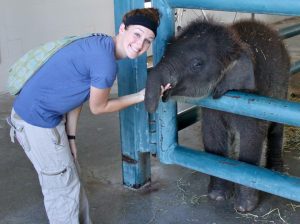Do you want to start your year feeling great about data and analytics? Then dive into this list and read a few data for good stories that you might have missed in 2018. You'll learn how data scientists are using analytics to save endangered species, prevent suicide, combat cancer - and more.

1. Detecting TB in elephants with data science
Meet Sarah Harden, a SAS data scientist with a passion for saving animals. Learn how she applied machine learning to help prevent the spread of TB among elephants. Her research could provide zookeepers and veterinarians with a practical field model they can use to quickly predict the likelihood of TB infection in any elephant within a herd.
2. Providing a smooth transition for military veterans
How can we support veterans as they transition back to civilian life? The Institute for Veterans and Military Families at Syracuse University uses data and analytics to serve those who have served their country.
3. Preventing domestic violence with wearables
After her sister became a victim of domestic violence, Kimberly Calhoun developed a wearable that collects data and reports on the offender's location in real-time, alerting police and protecting victims.
Being reactive is exhaustive and expensive. We need to start investing time and resources into prevention. - Kimberly Calhoun on preventing domestic violence #data4good Click To Tweet4. Improving outcomes for children with cancer
The Kids’ Cancer Project funds research in Australia and internationally to improve cancer survival rates for children and to reduce the negative effects of cancer treatments. This iTWire article explains how applying analytics to fundraising efforts can help fund more bold scientific research for saving kids' lives.
5. Protecting animals from extinction
Learn how analyzing footprints could help save cheetahs in Namibia and other endangered animals around the world. Amazingly, conservationists are researching how artificial intelligence may help us recreate some of the skills used by indigenous trackers. The answers could help us better understand what steps we need to take to save endangered species.
6. Preventing suicide with a data-driven approach
SAS helped Black Dog Institute implement a framework for evaluating the success of an innovative new suicide prevention initiative. Applying analytics to suicide prevention is having wide-ranging outcomes, including unprecedented data quality and the ability to measure the program’s impact across trial sites.
7. Bringing data to the stream
How much do we know about fresh water systems and the dynamic nature of streams and rivers? Find out how one data scientist turned his fascination with streams and rivers into a career that could help preserve one of our most precious and life sustaining resources.
8. Treating infections in premature babies
"The aim is to develop multiple models in SAS in order to better inform parents, provide the best possible healthcare for babies for a better long-term neurodevelopmental outcome and to eventually apply it to other intensive care departments," says Manon Benders, Professor and Head of Neonatology at UMC Utrecht.
9. Using DNA to drive life-changing results
The Healthy Nevada Project is combining genetic, clinical, environmental and socioeconomic data to better understand the complex interplay between these factors and related effects on population health. This first-of-its-kind study has the potential to help Nevada address some of its most complex population health problems – but investigators must first make sense of all the data.
10. Fighting cancer with real-world data
Only one in five low- and middle-income countries has the data necessary to drive cancer policy. The Latin American Cooperative Oncology Group in Brazil strives to change that, applying analytics to data from thousands of the region’s cancer patients to improve care and inform better health policy that saves lives.
